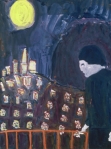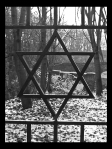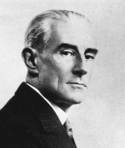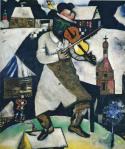
Jewish Cemetary in Krakow
The first time I heard the Kaddish, it struck me very deeply. I did not understand the language; I did not know what it was about. All I know is that it was the most beautiful melody I had ever heard. That opening phrase with its flattened second note of the scale was absolutely hypnotic. The language I did not know: strange and earthy. When it built to its climax, I was swept with it.
Ritualistic and from the depths of the soul, the Kaddish has been part of my life since I was a child. A scratchy old record from the music section of the Bloemfontein Municipal library became a powerful conduit of things for which it is hard to find terminology. Only years later would I learn that the actual words were a prayer, and what they meant. Having grown up in the dry formulaic asceticism of the Afrikaans Dutch Reformed Church, there was a definitely an element of “Orientalism” in my initial passion for this music. I responded to the unashamedly emotional expression of spirituality. As so often with Jewish music, not understanding the language or the context does not prohibit one from having a very strong emotional connection it. I would also be surprised to learn that the composer himself was not of the faith from which this prayer was drawn. And yet, the power of the music was strong enough to transcend these boundaries.
“For me, whenever I hear the end of the Ravel Kaddish—which uses a very clear motif from the High Holidays—an image always flashes in my mind of sitting next to my grandfather at High Holy Day services; I can almost taste the pickled herring my grandmother and I used to share at the end of our Yom Kippur fast. That’s the power of music—it can evoke associations above and beyond our understanding of the theological or liturgical significance of a particular service or holiday”. Cantor Andrew Bernard
Maurice Ravel’s “Jewish” works:
I first got to know the Kaddish in a setting by Maurice Ravel (1875 – 1937). Written in 1914, just before he enlisted for service in World War I, his Kaddish forms the first of two songs of the Deux mélodies hébraïques. Ravel uses the Aramaic text from the Jewish prayer book for the Kaddish, and the second song, L’Énigme éternelle is based on a traditional Yiddish verse. They were first performed in June 1914 by Alvina Alvi – who had commissioned them – with Ravel at the piano. In 1919 and 1920 Ravel orchestrated the two songs. Ravel had earlier set a Yiddish text “Mejerke, main Suhn” under the title Chanson hébraïque as the fourth of the Chants populaires (1910). Ravel’s mother was Basque, and Ravel is thought to have developed a certain affinity with Spain from her. His father was a Swiss clock-maker.
While many critics claim Ravel was influenced by composer Claude Debussy, Ravel himself claimed he was much more influenced by Mozart and Couperin, whose compositions are much more structured and classical in form. Ravel and Debussy were, however, clearly the defining composers of the impressionist movement. Ravel was also highly influenced by music from around the world, including American jazz, Asian music, and traditional folk songs from across Europe. Ravel had left the Roman Catholic Church and was a self-declared atheist, although he was also a spiritualist like many sceptics of his generation. He disliked the overtly religious themes of other composers, and instead preferred to look to classical mythology for inspiration. While Ravel’s music has tonal centres that never dissolve into atonality, his melodies are often modal. It is easy to see how the traditional modal melody of the Kaddish would have appealed to him. Ravel also was trict in his musical arrangements of folk material to leave the melodies unaltered.
Writer and critic Michel de Calvocoressi (1877-1944) met Ravel in 1898, and after an initial period of mutual suspicion, they became lifelong friends. It was Calvocoressi who provided Ravel with the folk texts to the Cinq mélodies populaires grecques. (1904-1906), and some suspect, the texts to the Deux mélodies hébraïques. Born in Greece, but educated in France, Calvocoressi was a skilled linguist and wrote in several languages, publishing books on Liszt, Moussorgsky and Schumann. Ravel dedicated the Alborada del Gracioso from the suite Mirroirs to him.
Significance and meanings of the Kaddish
The oldest version of the Kaddish is found in the Siddur of Rab Amram Gaon, c. 900.

“Kaddish” by Rex Sexton
Kaddish (קדיש Aramaic: “holy”) refers to an important and central prayer in the Jewish prayer service. The central theme of the Kaddish is the magnification and sanctification of God’s name. In the liturgy, several variations of the Kaddish are used functionally as separators between various sections of the service. The term “Kaddish” is often used to refer specifically to “The Mourners’ Kaddish,” said as part of the mourning rituals in Judaism in all prayer services as well as at funerals and memorials. When mention is made of “saying Kaddish”, this unambiguously denotes the rituals of mourning.
The opening words of this prayer are inspired by Ezekiel 38:23, a vision of God becoming great in the eyes of all the nations. The central line of the kaddish in Jewish tradition is the congregation’s response “May His great name be blessed forever and to all eternity”, a public declaration of God’s greatness and eternality. This response is a paraphrase of part of Daniel 2:20. The Mourners’, Rabbis’ and Complete Kaddish end with a supplication for peace, which is in Hebrew, and comes from the Bible. Along with the Shema and Amidah, the Kaddish is one of the most important and central prayers in the Jewish liturgy. Written in a mixture of Hebrew and Aramaic the Kaddish is about a half-page long text, primarily magnifying and glorifying God, as well as expressing a wish for a speedy coming of the Messianic era. It is recited primarily in the synagogue service after principal sections of the liturgy or at the beginning of such sections.

Kaddish Candle
“There are four main types of the synagogue Kaddish [there is also a fifth type recited at the cemetery], each containing a slightly different version of the text. In most occasions the service leader sings the Kaddish, with some congregational responses. The two main exceptions are the Kaddish recited by people in mourning or observing a death’s anniversary (Kaddish Yatom), and the Kaddish recited after a study session (Kaddish Derabannan). On these occasions the Kaddish is normally not sung but rather spoken out loud by the mourners or those who finished a study session” ( Boaz Tarsi, “Observations on Practices of Nusach in America,” Asian music, Volume xxxiii-2, 2002).
Ravel’s Kaddish: Sacred or Secular?
Despite the mournful tone of the melody, Ravel’s is a setting of the Chatzi Kaddish, rather than the full Mourner’s Kaddish, making it’s placing in a service in the synagogue more problematic than at first expected. The Chatzi Kaddish is a shorter version of the prayer that is used to demarcate sections of the liturgy. Unlike many other pieces of liturgical music written for synagogue use in the twentieth Century, Ravel’s setting is designed purely as a solo performance piece. No section of the work lends itself to choral or congregational participation. Given its setting of a liturgical text, many Orthodox Jews would consider this Kaddish a prayer, with its only rightful place in a service, and would see no need for it to be performed outside of that context. Given the exquisiteness of the work, its delicate accompaniment and the way it allows great artistic expressive freedom for the soloist, many would argue that it has a rightful place in the concert repertoire.
I encountered this work on an LP of Ravel’s orchestral works and have seen it in recital only once in my life. As a non-Jew I would have no other means of contact with this work. It is therefore ironic that I am trying to find an appropriate space within the Jewish High Holidays to perform this.
Kaddish Original Text
Yithgaddal weyithkaddash scheméh rabba
be’olmà diverà ‘khire’ outhé
veyamli’kl mal’khouté’khön,
ouvezome’khôu ouve’hayyé de’khol beth yisraël
ba’agalâ ouvizman qariw weimrou, Amen.
Yithbara’kh Weyischtaba’h weyith paêr
weyithroman weyithnassé weyithhaddar
weyith’allé weyithhallal
scheméh dequoudschâ beri’kh hou,
l’êla ule’êla min kol bri’khatha weschi’ratha
touschbehata wene’hamathâ daamirân ah!
Be’ olma ah! Ah! Ah! We imrou. Amen.
Kaddish: Free English translation by Boaz Tarsi
Magnified and sanctified be the name of God throughout the world
which He has created according to His will.
May He establish His kingdom during the days of our life
and the life of all speedily and soon and let us say Amen.
(Here normally comes a congregational response, which is missing from Ravel’s setting).
Exalted and glorified, lauded and praised,
Acclaimed and honored be the name of the Holy One
Blessed be He, praised beyond all blessings and hymns,
beyond all tributes that mortals can express and let us say Amen.

Spring in the Jewish Cemetary
Kaddish: Some recorded materials
Transliteration and pronounciation of the Aramaic, which proves that everybody speaks with an accent.
Baritone José Van Dam gives a powerful performance which would please those in search of an “authentic” male voice version. In this clip the pianist is not acknowledged, but it is likely to be French pianist and Van Dam’s long-term collaborator Jean-Philippe Collard. Belgian born, Van Dam was superb in French repertoire.
Soprano Montserrat Caballe sings a very finely crafted but perhaps overwrought Kaddish, although hampered by bad sound recording. She uses the sheetmusic through-out the entire recital. The pianissimi that were her stock in trade, takes one’s breath away.
A 1962 recording of Victoria de los Angeles presents the Kaddish in a rarely heard French version. Her singing always had a vulnerable human quality, which comes through in this recording.
Yehudi Menuhin performing a violin transcription of Ravel’s version. The power of the melody communicates the esesence of the text even in the absence of the language of words.
A Violin and Organ version by Alexander Skwortsow and Bert Mooiman reveal that sensitive performers can reinvent a piece of music
Ravel’s Kaddish is sung here in an orchestral version at the Nazi camp Auschwitz Birkenau. It is intended as a Mourner’s Kaddish, while technically it is a Chatzi Kaddish. To me this is of less importance, as the music speaks the text that might be “missing”. Daniel de Vicente – Tenor, Quadrivium Ensemble and Dan Rapoport – Conductor
Huw Morgan plays a trumpet transcription accompanied by pianist Nicholas Oliver in concert setting, ive from the BBC Young Musician Wigmore Hall Series 2006. It is played so beautifully and movingly that it could happily be transposed into a synagogue.
A modern soprano recording: Barbara Hendricks with John Eliot Gardiner in 1988.
Chanson hébraïque (“Mejerke, main Suhn” ) the fourth of the Chants populaires (1910) is sung here by Victoria de Los angeles accompanied by pianist Miguel Zanetti at the Teatro Real de Madrid (1980).

Jewish Memorial Berlin
Other aspects of the Kaddish:
Francis W. McBeth’s Kaddish for Band has received much attention from young bands and orchestras world wide.
An “artwork” of sorts is the “Mourner’s Kaddish“, using the context of the Kaddish as a means of coming to terms with the Holocaust. Joe Engel, a Holocaust surviver. It is very moving viewing.
The Holocaust is close to the surface in the Jewish pshyche. Ofra Haza created this Holocaust Kaddish for the 1990 Montreaux Jazz festival
An interesting meditation reflects on psychological impacts of the Kaddish .
Peter Pringle composed this Theremin Kaddish for Clara and performs it on the Theremin, an electronic instrument with surprisingly vocal quallities.
Non-Jewish composers creating “Jewish Music”
While orchestral and operatic music works by Jewish composers would in general be considered secular, many Jewish (as well as non-Jewish) composers have incorporated Jewish themes and motives into their music. Sometimes this is done covertly, such as the klezmer band music that many critics and observers believe lies in the third movement of Mahler’s Symphony No. 1, and this type of Jewish reference was most common during the 19th century when openly displaying one’s Jewishness would most likely hamper a Jew’s chances at assimilation. During the 20th century, however, many Jewish composers wrote music with direct Jewish references and themes, e.g. David Amram (Symphony – “Songs of the Soul”), Leonard Bernstein (Kaddish Symphony, Chichester Psalms), Ernest Bloch (Schelomo), Arnold Schoenberg (see below), Mario Castelnuovo-Tedesco (Violin Concerto no. 2) Kurt Weill (The Eternal Road) and Hugo Weisgall (Psalm of the Instant Dove).

Jewish Cemetary in Krakow
However, even during the 20th century some Jewish composers often quoted Jewish music within non-Jewish contexts; for example, Gershwin used liturgical melodies and Hebrew songs for a few numbers in Porgy and Bess, and many also believe that the opening clarinet glissando in his Rhapsody in Blue is a reference to klezmer. Finally, many non-Jewish (mostly, but not all, Russian) composers have composed classical music with clear Jewish themes and inspiration, such as Max Bruch (Kol Nidre), Sergei Prokofiev (Overture on Hebrew Themes), Dmitri Shostakovich (Second Piano Trio, From the Jewish Folk Poetry and Symphony No. 13 “Babi Yar”) and Igor Stravinsky (Abraham and Isaac – used the Hebrew Masoretic text of a passage of Genesis, and was dedicated to the Jews and the State of Israel).
Manyoperatic works by non-Jewish composers show a direct connection with and sympathy for the Jewish people and history, like Saint-Saëns’ Samson and Delilah (incidentally, Saint-Saëns’ composition teacher was Halevy) and Verdi’s Nabucco.
From the “All-Knowing-God-Of-Wiki” comes the following list of Kaddish used in various artforms:
Kaddish in the Arts (from WIKIPEDIA KADDISH)
The Kaddish has been a particularly common theme and reference point for Jewish writers, especially since the Haskalah.
- “Kaddish” is the title of an episode of the television show The X-Files (season 4, episode 15), in which a Golem is avenging a murder.
- “Kaddish” is the title of an episode of the television show Homicide: Life on the Street (season 5, episode 17), in which detective John Munch (Richard Belzer), who is Jewish, investigates the rape and murder of his childhood sweetheart.
- The Mourner’s Kaddish can be heard being recited by Collins and Roger during the song “La Vie Boheme” in the musical Rent.
- In the television series Drawn Together, Toot recites the Mourner’s Kaddish in the episode “A Very Special Drawn Together Afterschool Special,” after saying that her son was (metaphorically) dead.
- In Rocky III, Rocky Balboa recites the Mourners’ Kaddish for Mickey.
- In Philip Roth‘s novel The Human Stain, the narrator states that the Mourners’ Kaddish signifies that “a Jew is dead. Another Jew is dead. As though death were not a consequence of life but a consequence of having been a Jew.”
- In Final Fantasy VII Advent Children, one of the antagonists goes by the name of Kadaj, possibly a take on Kaddish, which keeps in line with the common use of religious symbolism throughout Final Fantasy VII (Jenova is another example of this.)
- In Tony Kushner‘s play Angels in America (and the subsequent TV miniseries), the characters of Julius and Ethel Rosenberg say the Kaddish over Roy Cohn‘s dead body.
- In the television show Everwood, Ephram Brown recites the Mourner’s Kaddish at his mother’s unveiling.
- The Kaddish can be heard in the opening credits of Schindler’s List.
- In Yentl, at her father’s burial, the rabbi asks who will say Kaddish (Kaddish is traditionally said by a son). Yentl replies that she will and, to the horror of those assembled, grabs the siddur and starts saying Kaddish.
- Kaddisch is the first of Ravel‘s two songs Deux mélodies hébraïques.
- The fictional character Dan Turpin was killed by Darkseid in Superman: The Animated Series, and at his funeral, there was a Rabbi saying Kaddish. After the episode, there was a message that the episode was dedicated to Jack Kirby, a Jewish comic book artist, who influenced the entire comic book community.
- In Torch Song Trilogy, the main character Arnold Beckoff says the Mourner’s Kaddish for his murdered lover, Alan, much to the horror of his mother.
- Kaddish For Uncle Manny[6]” from the 4th season of Northern Exposure (first aired 5-3-93) relates to Joel’s (Rob Morrow) seeking out of ten Jews in remote Alaska to join him for Kaddish in memory of his recently departed Uncle Manny in New York City. Maurice Minnifield (Barry Corbin) takes to Alaska’s airwaves and offers a cash stipend for Jews in KBHR’s listening area to trek to Cicely in order to form a minyan, or the prerequisite ten adult males, to accompany his recital of the prayer. As strangers appear from nowhere, Joel realizes that his mitzvah to say Kaddish for his uncle is best accomplished through the presence of his new Cicely family, who although Gentile, are most near and dear to him as compared with ten ‘mercenary’ Jews who are unknown to him. The episode ends with Joel leading the townspeople through the service.
- Nobel Laureate Imre Kertesz‘s “Kaddish for an Unborn Child“
- Zadie Smith’s novel “The Autograph Man” revolves around Alex-Li Tandem, a dealer in autograph memorabilia whose father’s Yahrzeit is approaching. The epilogue of the novel features a scene in which Alex-Li recites Kaddish with a minyan.
- In Frederick Forsyth‘s novel The Odessa File, a Jew who commits suicide in 1960s Germany requests in his diary/suicide note that someone say Kaddish for him in Israel. At the end of the Novel, a Mossad agent involved in the plot, who comes into possession of the diary, fulfils the dead man’s wish

Jewish Cemetery in Prague



Thanks Albert for including me .I was absolutely absorbed in your research on the music of Jewish New Year services. You have taught me so much and I feel the music, even though I dont hear it, through your discriptions.
Thanks love Mom
Thank you Albert – fascinating and informative!